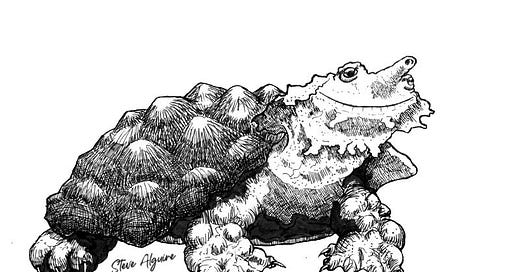Happy New Year, friends! Welcome to the first issue of Mouse and Minnow for 2022. We’re excited to be back for more weekly celebrations of animals. If you’re a new reader, you can always go back and explore previous issues by featured animal.
Now onto this week’s animal, a turtle who likes to lay low but still manages to stand out:
Matamata Smile
Quiet sits the matamata
Underneath the watawata
Dressed in camouflagaflaga
Like a leafy loggalogga.
Soon a fish he's caughtacaughta
That the current broughtabroughta.
He smiles at the thoughtathoughta:
”That sure hit the spotaspota.”
~ Marilyn Anne Campbell
Matamata Chitta-Chatta
Matamatas are wonderfully unique-looking freshwater turtles from South America. They have a knobby shell and fleshy fringes on their neck and face that help them look like algae-covered logs, rocks, and fallen leaves when they sit still underwater. And underwater is where they like to stay. Unlike turtles who enjoy basking in the sun, nocturnal matamatas are very comfortable staying submerged as much as possible in the still or slow-moving waters where they prefer to live.
Their natural camouflage is key to their hunting strategy, which involves holding still or moving very slowly until a small fish comes within range. Then, exactly when another turtle might snap out with a sharp beak, a matamata will instead open their wide mouth and create a vacuum that sucks the fish in whole.
Speaking of that mouth, it cuts across the matamata's flat, triangular head in a way that gives these turtles the look of having a permanent grin (at least to the human eye; fish probably don't find it as charming). Finishing out the matamata's look is a snorkel-like nose which, in shallow water, means they can take a breath just by stretching their long neck up rather than swimming to the surface.
Until 2020 the matamata was considered a single species, but after closer study scientists determined there were enough differences between matamata living in and around different river basins to split the animals into two separate species. The Amazon Matamata remains Chelus fimbriata while the "new" Orinoco Matamata is Chelus orinocensis.
But no matter the mata, these turtles have basically evolved to chill out and wait for food to come to them. So maybe that is a real smile after all.
Links
Read profiles of Chelus fimbriata on the Smithsonian National Zoo’s website or on the University of Michigan’s Animal Diversity Web
Matamatas can be targets of illegal smuggling, but the development of rapid DNA testing kits for the turtles is helping officials quickly return recovered matamatas to their home waters. Read “DNA test kit saves thousands of Earth’s most bizarre turtles” on the Florida International University website for all the fascinating details.
See their camouflage in action with the YouTube video “Matamata Turtle in the Yasuni.” (Just some decomposing leaves, nothing to see here…)
And of course, watch a matamata vacuum up fish in the YouTube video “The Matamata Turtle” from New Atlantis Wild:
Share a Thoughtathoughta
If you liked this issue you can click the heart at the top or bottom of this post to let us know, and consider forwarding or sharing this issue with others you think might enjoy it.
If you’re a subscriber you can reply to this email in your inbox to send a note to Marilyn and Steve directly, or anyone can leave a public comment on the online archive:
We also have Reader Survey for your general (and anonymous) thoughts on what you’d like to see more or less of in the newsletter. Thanks to those who have already filled it out!
About & Subscribe
Mouse and Minnow is co-created by partners Steve Alguire (illustration) and Marilyn Anne Campbell (writing). Learn more about the newsletter and use the free subscribe button below to receive original art and writing about animals right in your inbox.
(Please note: This newsletter is hosted through Substack.com. Before subscribing, you should be sure that you consent to Substack’s terms, including their privacy policy and the information collection notice found under their CCPA Policy.)
© All images and text are copyright the respective author. You are encouraged to share this newsletter with others by forwarding it or sharing the link, but all other uses, including reposting or publishing individual or complete content, are not permitted.



